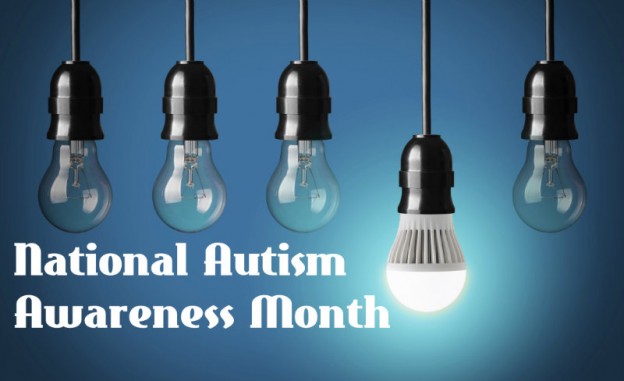
Products 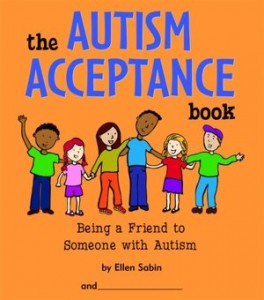 by Ellen Sabin with illustrations by Kerren Barbas
This is a wonderful character-building, activity book for children 6 years and up. Parents and teachers must help those in their care to embrace differences in others with respect, compassion, and kindness.
The Autism Acceptance Book, with its FUN, easy-to-do activities, brings the child to the conclusion that like everyone else, people with autism have their own special skills and challenges. Also like everyone else, each autistic person may feel and act in different ways. By reading and doing the engaging exercises, readers will understand that their peers with autism also want to be liked, understood, accepted, and included.
One chapter shows children how and why to accept others. Another teaches them how people are different from one another when you consider their looks, skills, challenges, fears, and personality. Kids will read that some people with autism have a problem in the way their brains deal with the information that they get from their senses.
The main part of the book, You and Your Friends with Autism helps them understand what makes them different and special and how they can be a good friend by helping their friend with autism cope with his challenges. Ms. Sabin has eight sub-sections describing how some people with autism may experience different reactions than the reader does.
Read complete review here.
by Ellen Sabin with illustrations by Kerren Barbas
This is a wonderful character-building, activity book for children 6 years and up. Parents and teachers must help those in their care to embrace differences in others with respect, compassion, and kindness.
The Autism Acceptance Book, with its FUN, easy-to-do activities, brings the child to the conclusion that like everyone else, people with autism have their own special skills and challenges. Also like everyone else, each autistic person may feel and act in different ways. By reading and doing the engaging exercises, readers will understand that their peers with autism also want to be liked, understood, accepted, and included.
One chapter shows children how and why to accept others. Another teaches them how people are different from one another when you consider their looks, skills, challenges, fears, and personality. Kids will read that some people with autism have a problem in the way their brains deal with the information that they get from their senses.
The main part of the book, You and Your Friends with Autism helps them understand what makes them different and special and how they can be a good friend by helping their friend with autism cope with his challenges. Ms. Sabin has eight sub-sections describing how some people with autism may experience different reactions than the reader does.
Read complete review here.
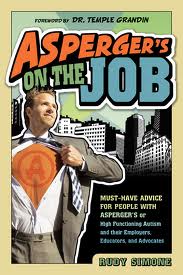 Must-Have Advice for People with Asperger’s or High Functioning Autism and their Employers, Educators, and Advocates
by Rudy Somone
At first glance, the book only seems to be a resource to help employers accommodate their employees with Asperger’s or High Functioning Autism and for these employees to find and keep gainful employment. Once you start reading, you quickly realize the valuable insight Rudy Simone reveals about Asperger’s Syndrome and about many aspects of the daily challenges Aspergians face.
Simone has practical solutions for Aspies on how to make better choices from choosing the correct career path, to the right work place. Her recommendations on how the neurotypical population could accommodate the growing number of employees on the spectrum make it a go-to book for all groups of readers.
Her twenty short chapters are often supported by true stories or quotes and always end with a list of what the employee can do, followed by a list of suggestions to employers and advocates. The author finishes each chapter with a few thought provoking or self-searching questions and she has even left blank spaces for your answers. To quickly locate information, if you cannot find it in the table of contents, you will surely zero in on exactly what you are looking for in the detailed index.
Read complete review here.
Must-Have Advice for People with Asperger’s or High Functioning Autism and their Employers, Educators, and Advocates
by Rudy Somone
At first glance, the book only seems to be a resource to help employers accommodate their employees with Asperger’s or High Functioning Autism and for these employees to find and keep gainful employment. Once you start reading, you quickly realize the valuable insight Rudy Simone reveals about Asperger’s Syndrome and about many aspects of the daily challenges Aspergians face.
Simone has practical solutions for Aspies on how to make better choices from choosing the correct career path, to the right work place. Her recommendations on how the neurotypical population could accommodate the growing number of employees on the spectrum make it a go-to book for all groups of readers.
Her twenty short chapters are often supported by true stories or quotes and always end with a list of what the employee can do, followed by a list of suggestions to employers and advocates. The author finishes each chapter with a few thought provoking or self-searching questions and she has even left blank spaces for your answers. To quickly locate information, if you cannot find it in the table of contents, you will surely zero in on exactly what you are looking for in the detailed index.
Read complete review here.
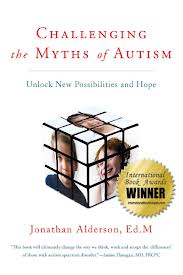 Mr. Alderson examines seven stereotypical characterizations or “myths of autism”. He has a chapter on each of these perennially inaccurate descriptions. Each chapter explains the origins of the seven myths and discusses the evidence refuting them. The author invites the reader to put aside their preconceived notions of autism which can mislead parents, therapists, and the general public to underestimate the potential of children with autism.
My favorite feature is Jonathan Alderson’s writing style. While reading his book it feels you are having a conversation with a friend. He expertly weaves real-life stories of autistic children he has worked with to make his point. Often he will bring up that same child in another section of the book. Alderson often supports his ideas with quotes from other authors or researchers. Sprinkled in each chapter are quotes in larger, grey font. Often he calls the reader to action with his sub-headings, “What Teachers and Schools Can Do Differently” or “What You Can Do”
Read complete review here.
Mr. Alderson examines seven stereotypical characterizations or “myths of autism”. He has a chapter on each of these perennially inaccurate descriptions. Each chapter explains the origins of the seven myths and discusses the evidence refuting them. The author invites the reader to put aside their preconceived notions of autism which can mislead parents, therapists, and the general public to underestimate the potential of children with autism.
My favorite feature is Jonathan Alderson’s writing style. While reading his book it feels you are having a conversation with a friend. He expertly weaves real-life stories of autistic children he has worked with to make his point. Often he will bring up that same child in another section of the book. Alderson often supports his ideas with quotes from other authors or researchers. Sprinkled in each chapter are quotes in larger, grey font. Often he calls the reader to action with his sub-headings, “What Teachers and Schools Can Do Differently” or “What You Can Do”
Read complete review here.
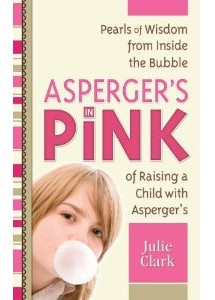 Julie Clark walks us through the lengthy process of getting the proper diagnosis for her daughter with Asperger’s and blames this partly on the fact that her child is a girl. In her forward, Rudy Simone also upholds the fact that the female gender often goes undiagnosed and even receives multiple misdiagnoses. This results in not having access to the proper care and support.
A delayed diagnosis leaves the family struggling to prove that their child’s unique behavior is not due to bad parenting or willful misbehaving. Clark points out that one of the most difficult aspects of their journey has been the feeling of being misunderstood and under a microscope as a family unit.
You will easily relate to Julie’s explanation on how they needed lots of perseverance, patience and prayers to deal with friendships, play dates, invitations to parties, school group projects, playground and lunch time friends and family outings and vacations. Follow the Clarks, armed with Social Stories in pockets, trying to interest Kristina in extracurricular activities to learn to interact with peers
Read complete review here.
Julie Clark walks us through the lengthy process of getting the proper diagnosis for her daughter with Asperger’s and blames this partly on the fact that her child is a girl. In her forward, Rudy Simone also upholds the fact that the female gender often goes undiagnosed and even receives multiple misdiagnoses. This results in not having access to the proper care and support.
A delayed diagnosis leaves the family struggling to prove that their child’s unique behavior is not due to bad parenting or willful misbehaving. Clark points out that one of the most difficult aspects of their journey has been the feeling of being misunderstood and under a microscope as a family unit.
You will easily relate to Julie’s explanation on how they needed lots of perseverance, patience and prayers to deal with friendships, play dates, invitations to parties, school group projects, playground and lunch time friends and family outings and vacations. Follow the Clarks, armed with Social Stories in pockets, trying to interest Kristina in extracurricular activities to learn to interact with peers
Read complete review here.
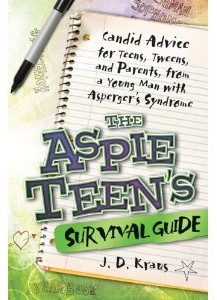 -by J. D. Kraus,
This survival guide will help you to better understand individuals with Asperger’s syndrome (AS).
If you are a person with Asperger’s syndrome, you will also benefit from J.D. Kraus’ go-to-guide of survival just to know you are not alone. If you only had an Asperger’s diagnosis when you were older, reliving your school years side by side with Kraus as “big brother explaining things” will lighten your load of unexplained crises, unhappy feelings, and unobtainable goals. Some of these issues you have been carrying since your school years. A must read for all educators to realize the impact and influence they have on the lives of all students with special needs.
The Aspie Teen’s Survival Guide covers most topics that are a thorn in the lives of youth with Asperger’s. It is a resource book you will be able to refer to often and easily to find solutions and explanations. You will find the well-organized chapters with precise titles and a detailed index make this a handy book to give to teachers, family members or friends who could benefit from Kraus’ sound and sage advice.
Read complete review here.
-by J. D. Kraus,
This survival guide will help you to better understand individuals with Asperger’s syndrome (AS).
If you are a person with Asperger’s syndrome, you will also benefit from J.D. Kraus’ go-to-guide of survival just to know you are not alone. If you only had an Asperger’s diagnosis when you were older, reliving your school years side by side with Kraus as “big brother explaining things” will lighten your load of unexplained crises, unhappy feelings, and unobtainable goals. Some of these issues you have been carrying since your school years. A must read for all educators to realize the impact and influence they have on the lives of all students with special needs.
The Aspie Teen’s Survival Guide covers most topics that are a thorn in the lives of youth with Asperger’s. It is a resource book you will be able to refer to often and easily to find solutions and explanations. You will find the well-organized chapters with precise titles and a detailed index make this a handy book to give to teachers, family members or friends who could benefit from Kraus’ sound and sage advice.
Read complete review here.
Five Autism Books to Celebrate National Autism Awareness Month
Every April since the 1970’s, we are invited to celebrate National Autism Awareness Month (NAAM). The tag line for 2014 is “A Better World for Autism”. The seventh annual World Autism Awareness Day (WAAD) is April 2nd. 2014. In 2010, Autism Speaks launched a project in support of WAAD called Light It Up Blue. Landmarks, social media sites, and communities around the world Light It Up Blue to show their support and show we must educate the public about autism, about inclusive services, and issues within the autism community. My book recommendations this month are books about autism. Most of these books are for parents raising a child on the autism spectrum but they are also wonderful for teachers, friends, and family members to also learn about the challenges these families face and the strategies that can be used to make their children’s lives better. We are told over 2 million individuals in the U.S. and tens of millions worldwide are autistic; therefore, rarely does a day go by that we do not interact with someone on the autism spectrum.1. The Autism Acceptance Book: Being A Friend To Someone with Autism
 by Ellen Sabin with illustrations by Kerren Barbas
This is a wonderful character-building, activity book for children 6 years and up. Parents and teachers must help those in their care to embrace differences in others with respect, compassion, and kindness.
The Autism Acceptance Book, with its FUN, easy-to-do activities, brings the child to the conclusion that like everyone else, people with autism have their own special skills and challenges. Also like everyone else, each autistic person may feel and act in different ways. By reading and doing the engaging exercises, readers will understand that their peers with autism also want to be liked, understood, accepted, and included.
One chapter shows children how and why to accept others. Another teaches them how people are different from one another when you consider their looks, skills, challenges, fears, and personality. Kids will read that some people with autism have a problem in the way their brains deal with the information that they get from their senses.
The main part of the book, You and Your Friends with Autism helps them understand what makes them different and special and how they can be a good friend by helping their friend with autism cope with his challenges. Ms. Sabin has eight sub-sections describing how some people with autism may experience different reactions than the reader does.
Read complete review here.
by Ellen Sabin with illustrations by Kerren Barbas
This is a wonderful character-building, activity book for children 6 years and up. Parents and teachers must help those in their care to embrace differences in others with respect, compassion, and kindness.
The Autism Acceptance Book, with its FUN, easy-to-do activities, brings the child to the conclusion that like everyone else, people with autism have their own special skills and challenges. Also like everyone else, each autistic person may feel and act in different ways. By reading and doing the engaging exercises, readers will understand that their peers with autism also want to be liked, understood, accepted, and included.
One chapter shows children how and why to accept others. Another teaches them how people are different from one another when you consider their looks, skills, challenges, fears, and personality. Kids will read that some people with autism have a problem in the way their brains deal with the information that they get from their senses.
The main part of the book, You and Your Friends with Autism helps them understand what makes them different and special and how they can be a good friend by helping their friend with autism cope with his challenges. Ms. Sabin has eight sub-sections describing how some people with autism may experience different reactions than the reader does.
Read complete review here.
2. Asperger’s on the Job
 Must-Have Advice for People with Asperger’s or High Functioning Autism and their Employers, Educators, and Advocates
by Rudy Somone
At first glance, the book only seems to be a resource to help employers accommodate their employees with Asperger’s or High Functioning Autism and for these employees to find and keep gainful employment. Once you start reading, you quickly realize the valuable insight Rudy Simone reveals about Asperger’s Syndrome and about many aspects of the daily challenges Aspergians face.
Simone has practical solutions for Aspies on how to make better choices from choosing the correct career path, to the right work place. Her recommendations on how the neurotypical population could accommodate the growing number of employees on the spectrum make it a go-to book for all groups of readers.
Her twenty short chapters are often supported by true stories or quotes and always end with a list of what the employee can do, followed by a list of suggestions to employers and advocates. The author finishes each chapter with a few thought provoking or self-searching questions and she has even left blank spaces for your answers. To quickly locate information, if you cannot find it in the table of contents, you will surely zero in on exactly what you are looking for in the detailed index.
Read complete review here.
Must-Have Advice for People with Asperger’s or High Functioning Autism and their Employers, Educators, and Advocates
by Rudy Somone
At first glance, the book only seems to be a resource to help employers accommodate their employees with Asperger’s or High Functioning Autism and for these employees to find and keep gainful employment. Once you start reading, you quickly realize the valuable insight Rudy Simone reveals about Asperger’s Syndrome and about many aspects of the daily challenges Aspergians face.
Simone has practical solutions for Aspies on how to make better choices from choosing the correct career path, to the right work place. Her recommendations on how the neurotypical population could accommodate the growing number of employees on the spectrum make it a go-to book for all groups of readers.
Her twenty short chapters are often supported by true stories or quotes and always end with a list of what the employee can do, followed by a list of suggestions to employers and advocates. The author finishes each chapter with a few thought provoking or self-searching questions and she has even left blank spaces for your answers. To quickly locate information, if you cannot find it in the table of contents, you will surely zero in on exactly what you are looking for in the detailed index.
Read complete review here.
3. Challenging the Myths of Autism: Unlock New Possibilities and Hope
by Jonathan Alderson Mr. Alderson examines seven stereotypical characterizations or “myths of autism”. He has a chapter on each of these perennially inaccurate descriptions. Each chapter explains the origins of the seven myths and discusses the evidence refuting them. The author invites the reader to put aside their preconceived notions of autism which can mislead parents, therapists, and the general public to underestimate the potential of children with autism.
My favorite feature is Jonathan Alderson’s writing style. While reading his book it feels you are having a conversation with a friend. He expertly weaves real-life stories of autistic children he has worked with to make his point. Often he will bring up that same child in another section of the book. Alderson often supports his ideas with quotes from other authors or researchers. Sprinkled in each chapter are quotes in larger, grey font. Often he calls the reader to action with his sub-headings, “What Teachers and Schools Can Do Differently” or “What You Can Do”
Read complete review here.
Mr. Alderson examines seven stereotypical characterizations or “myths of autism”. He has a chapter on each of these perennially inaccurate descriptions. Each chapter explains the origins of the seven myths and discusses the evidence refuting them. The author invites the reader to put aside their preconceived notions of autism which can mislead parents, therapists, and the general public to underestimate the potential of children with autism.
My favorite feature is Jonathan Alderson’s writing style. While reading his book it feels you are having a conversation with a friend. He expertly weaves real-life stories of autistic children he has worked with to make his point. Often he will bring up that same child in another section of the book. Alderson often supports his ideas with quotes from other authors or researchers. Sprinkled in each chapter are quotes in larger, grey font. Often he calls the reader to action with his sub-headings, “What Teachers and Schools Can Do Differently” or “What You Can Do”
Read complete review here.
4. Asperger’s in Pink
Pearls of Wisdom from Inside the Bubble of Raising a Child with Asperger’s – by Julie Clark Julie Clark walks us through the lengthy process of getting the proper diagnosis for her daughter with Asperger’s and blames this partly on the fact that her child is a girl. In her forward, Rudy Simone also upholds the fact that the female gender often goes undiagnosed and even receives multiple misdiagnoses. This results in not having access to the proper care and support.
A delayed diagnosis leaves the family struggling to prove that their child’s unique behavior is not due to bad parenting or willful misbehaving. Clark points out that one of the most difficult aspects of their journey has been the feeling of being misunderstood and under a microscope as a family unit.
You will easily relate to Julie’s explanation on how they needed lots of perseverance, patience and prayers to deal with friendships, play dates, invitations to parties, school group projects, playground and lunch time friends and family outings and vacations. Follow the Clarks, armed with Social Stories in pockets, trying to interest Kristina in extracurricular activities to learn to interact with peers
Read complete review here.
Julie Clark walks us through the lengthy process of getting the proper diagnosis for her daughter with Asperger’s and blames this partly on the fact that her child is a girl. In her forward, Rudy Simone also upholds the fact that the female gender often goes undiagnosed and even receives multiple misdiagnoses. This results in not having access to the proper care and support.
A delayed diagnosis leaves the family struggling to prove that their child’s unique behavior is not due to bad parenting or willful misbehaving. Clark points out that one of the most difficult aspects of their journey has been the feeling of being misunderstood and under a microscope as a family unit.
You will easily relate to Julie’s explanation on how they needed lots of perseverance, patience and prayers to deal with friendships, play dates, invitations to parties, school group projects, playground and lunch time friends and family outings and vacations. Follow the Clarks, armed with Social Stories in pockets, trying to interest Kristina in extracurricular activities to learn to interact with peers
Read complete review here.
5. The Aspie Teen’s Survival Guide: Candid Advice for Teens, Tweens, and Parents, from a Young Man with Asperger’s Syndrome
 -by J. D. Kraus,
This survival guide will help you to better understand individuals with Asperger’s syndrome (AS).
If you are a person with Asperger’s syndrome, you will also benefit from J.D. Kraus’ go-to-guide of survival just to know you are not alone. If you only had an Asperger’s diagnosis when you were older, reliving your school years side by side with Kraus as “big brother explaining things” will lighten your load of unexplained crises, unhappy feelings, and unobtainable goals. Some of these issues you have been carrying since your school years. A must read for all educators to realize the impact and influence they have on the lives of all students with special needs.
The Aspie Teen’s Survival Guide covers most topics that are a thorn in the lives of youth with Asperger’s. It is a resource book you will be able to refer to often and easily to find solutions and explanations. You will find the well-organized chapters with precise titles and a detailed index make this a handy book to give to teachers, family members or friends who could benefit from Kraus’ sound and sage advice.
Read complete review here.
-by J. D. Kraus,
This survival guide will help you to better understand individuals with Asperger’s syndrome (AS).
If you are a person with Asperger’s syndrome, you will also benefit from J.D. Kraus’ go-to-guide of survival just to know you are not alone. If you only had an Asperger’s diagnosis when you were older, reliving your school years side by side with Kraus as “big brother explaining things” will lighten your load of unexplained crises, unhappy feelings, and unobtainable goals. Some of these issues you have been carrying since your school years. A must read for all educators to realize the impact and influence they have on the lives of all students with special needs.
The Aspie Teen’s Survival Guide covers most topics that are a thorn in the lives of youth with Asperger’s. It is a resource book you will be able to refer to often and easily to find solutions and explanations. You will find the well-organized chapters with precise titles and a detailed index make this a handy book to give to teachers, family members or friends who could benefit from Kraus’ sound and sage advice.
Read complete review here.



